At Goonhammer, our passion for games extends well beyond the tabletop. These aren’t just limited to Warhammer games, as this week SRM is reviewing Fallout 76 and its new Wastelanders expansion.
I’ve spent somewhere north of 1,000 hours with the Fallout franchise. I lost my freshman year of college to Fallout 3, a significant portion of my early 20s to New Vegas, took time off work for both Fallout 4 and 76, blitzed through Fallout 1 and much of Tactics, and at the time of this writing, am on my second playthrough of Fallout 2. The (mostly) lovely miniatures for the Fallout: Wasteland Warfare tabletop game from Modiphius have even found their way to my painting table, although I’ve yet to actually play the associated game.
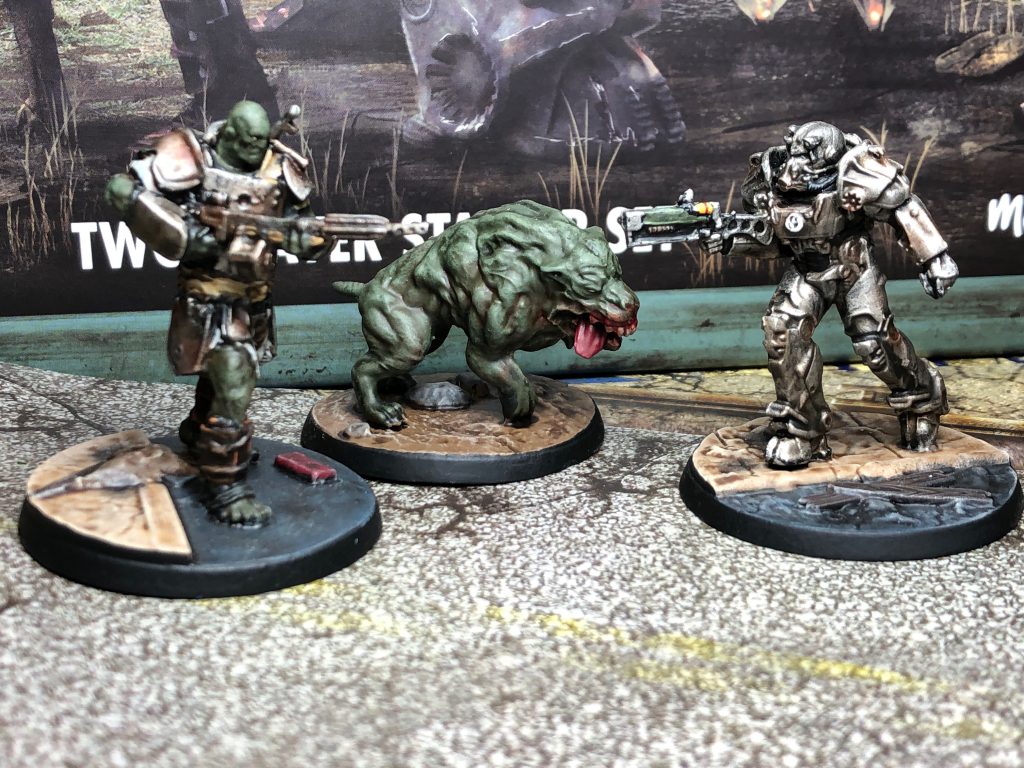
Hell, I’ve even made cartoons about the series. Suffice to say, I really dig Fallout, and readers should understand that this review is from someone who really gives a shit about the franchise. Needing somewhere to dump my thoughts regarding this latest (and just refreshed) entry into the series, the Goonhammer overseers have granted me the opportunity to write entirely too many words about Fallout 76.
War Never Changes, Except For When It Does
Fallout has been a series of open world RPGs running back to the late 90s. The series is set in a post-nuclear America, where the failed optimism of the Atomic Age meets the apocalyptic barbarism of Mad Max and the writings of Harlan Ellison and Roger Zelazny. It’s extremely Gen-X. Once Bethesda took over the reins from Interplay with Fallout 3, they traded some of that nihilism for more wackadoo midcentury SCIENCE! imagery and marketable appeal, and the series has grown in popularity since. The isometric viewpoint of the originals was traded for first person shootin’ and lootin’, and a well-regarded but somewhat obscure CRPG series suddenly became a best seller. The latest entry, Fallout 76, is Bethesda’s take on a multiplayer games-as-service Fallout game.
Fallout 76 takes place in West Virginia, and is set in 2102, years earlier than any other game in the franchise. Players emerge from the titular Vault 76 into a hostile world full of irradiated monsters, cannibalistic ghouls, and for the first time, other players, whose motives are all their own. It is up to the vault dwellers to find out what happened to the world they left behind, and just where their overseer ran off to. It leans into the survival elements previous games have flirted with, with a much heavier emphasis on crafting and building. This means players have to hunt, scavenge, fight and build to stay alive. It all feels very natural for players living in a post-apocalyptic environment.
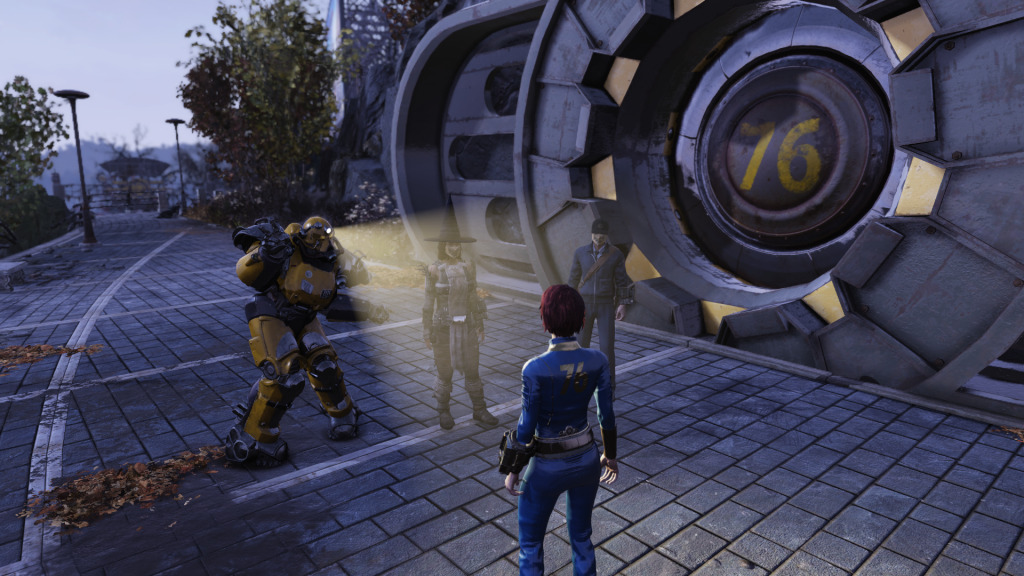
Fallout 1st Things Fallout 1st
To say the game had a rough launch is an understatement. I won’t get too in the weeds here, but the hyperbolizing and chicken little-ing around it was largely earned. Bethesda’s trademark bugs stacked on top of a series of poorly executed and transparent cashgrabs and attempts at relevancy made for a rough first year, and each successive update failed to address the core issues with the base game. A threadbare story, repetitive gameplay loop, and broken economy weren’t exactly fixed by adding an also-ran battle royale mode, paid for private servers, and an expensive cash shop. However, something kept people playing. Maybe not a ton of people, but there was a fairly active community keeping the game alive between then and now. What kept them around?
Something S.P.E.C.I.A.L.
The Fallout community has always been a passionate one, and the parts of the community sticking with 76 even moreso. Almost immediately you had players roleplaying as raiders, wine moms, first responders, mail carriers, bounty hunters, bartenders and cannibalistic cultists, using their fashion sense and individual home bases (C.A.M.P.s in the parlance of the game) to emphasize their characters and playstyles. The community is also a generous one – it’s common to see high level players dropping bags of ammo and medical supplies for new players, or to take less experienced players under their wing and teach them the intricacies of cooking, crafting, combat, and the game’s more obtuse interactions.
Even at launch, there’s a lot to like about Fallout 76. It preserves Fallout 4’s combat, which I already enjoyed quite a bit. It’s no DOOM: Eternal, but the gunplay feels good. It also carries over and gives center stage to Fallout 4’s crafting system, granting players tons of freedom to customize their equipment and homes. This take on West Virginia is also as expansive and diverse a setting as any Fallout wasteland. The different regions of the map are each distinct and are full of little stories telling players what happened there – if players are willing to dig them up. There’s always something over the next horizon, and the best thing is, you can discover that with your friends.
I spent a good hundred hours with 76 in its early days, starting with the beta and taking a week off work with my wife so we could play together. Discovering the stories behind the world and exploring it together was a ton of fun, and it was easier to actually hear those stories when one of us could play an audio log while the other turned their volume down. Growing as players and discovering everything the game had to offer was exciting to do together, and a lot of the game’s rougher points were smoothed out by that social interaction.
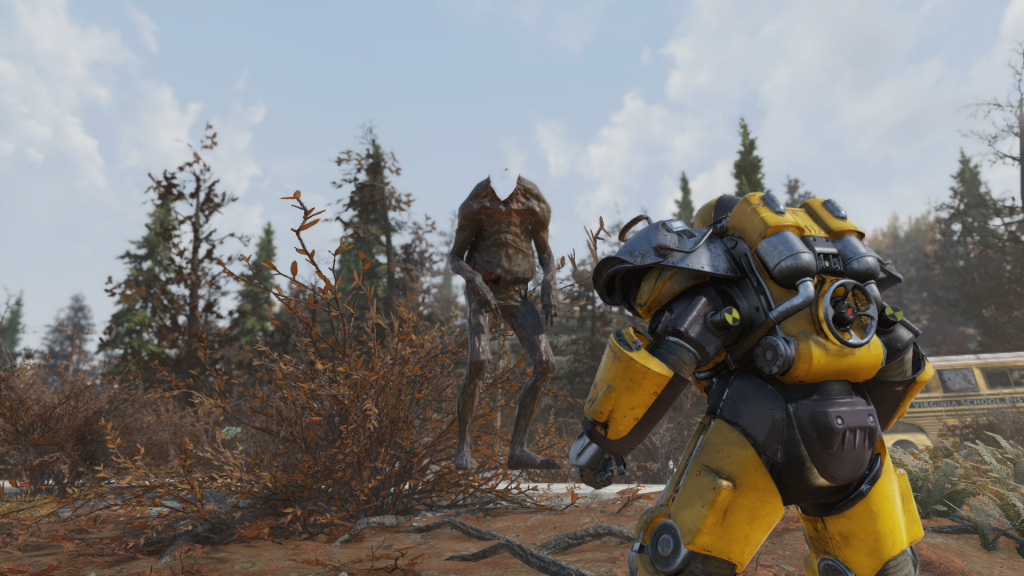
Over time some of our more MMO-savvy friends started to join us, which let us experience the game’s loot system and more focused character builds. We went on raids together, hunted the game’s high level Scorchbeasts, and tracked down the components and blueprints to build some of the game’s higher level armor. It was almost like a whole different game bolted onto what we’d experienced!
Fallout’s Fallout
Unfortunately, that dichotomy is one of 76’s greatest points of friction. West Virginia is littered with stories of survivors, pre-war business magnates, strikers and soldiers, and it’s real hard to pay attention to their audio logs or journal entries while your friends are going off about their dogs or day jobs. So much of Fallout up until now has been a solitary experience, and it’s awkward to have it shoved into a multiplayer one. Story is difficult to convey effectively when there are other players to offer distraction, and telling your party of friends to shut up so you can listen to an NPC’s last words isn’t fun for anybody.
This presents a tonal challenge, as the story of Fallout 76 is a somber one. Players are exploring the ruins of a world not dissimilar to our own, with journals espousing fears of environmental catastrophe, job loss to automation, violations of labor and human rights, inequality, loss, and the desolation of rural America. These are communicated via some excellent voice work and solid writing, and finding the last resting place of someone who was once so chipper and hopeful can be affecting. Then you look just out of frame and there’s a jamoke with a gold plated .50 cal and a giant bear helmet hopping up and down and spamming the vomit emote.
To get a grip on this tonal split, watch the original launch trailer for the game and follow it up with the profoundly silly live action trailer. Then, for a true Fallout 76 experience, play them at the same time. This isn’t exactly a chocolate and peanut butter situation. While there were some genuinely good stories hidden away in the launch version of Fallout 76, finding trails of breadcrumbs will only take some players so far. Every trail ended in a comically posed skeleton, hidden grave, or dubiously fresh corpse. The quests consisted almost entirely of “Go to X, kill Y”, which gets old after a while. Some quests could even take you back to somewhere you’d just cleared out only to do it again, and fighting the same bunch of Scorched twice in the same room isn’t exactly compelling quest design. Lastly, the world just didn’t feel alive. You could find plenty of immediately hostile monsters to shoot, but if you were to ask any player of a previous Fallout game what their favorite parts of the series were, they would invariably point you towards its factions and the memorable characters therein. Ultimately, players wanted a role playing game and a true Fallout experience, not this awkward blend of RPG and survival game à la Rust.

Even to the crew I was running with, the original 76 experience grew stale. We could only go around the same nuked locations over and over again, grinding for slightly better random loot. None of us need to hear “Grrrrrrrafton’s mayor!” ever again. The cracks were all on display, and the game had functionally run out of steam for the lot of us.
Reclamation Day
It only took a year and a half to turn around, but the free Wastelanders update addresses a load (but not all) of these problems. Calling it an update is kind of an understatement – it adds dozens of hours of quests, characters, locations, and gear to the game, and practically makes a whole new game out of 76. I’ve seen a lot of buzz that this is what the game should have looked like at launch, and I’m not inclined to disagree.
Wastelanders introduces the creatively named Settlers and Raiders to West Virginia, giving players new hubs to travel to and trade at, and plenty of new characters to meet. There were a few robots who talked at you before, but players can enter conversations with these new NPCs and actually choose dialog options and have conversations with them. There are even skillchecks in these dialogs, letting players learn more or skip entire sections of quests with the right spread of their S.P.E.C.I.A.L. skills. Imagine that, playing a role in a role playing game! In one particular early game quest, the player is trying to convince the two warring factions to inoculate their populaces from the Scorched plague that ravaged West Virginia the first time around. Interestingly, the first year or so of the game is still canon, and if you played during that time and accomplished a number of those quests, you get a leg up on some of these new ones. While my character had a high enough Intelligence to convince the Wasteland anti-vaxxer that the Scorched plague was real and terrifying, my friend’s character wasn’t, meaning they had to go on a whole new quest to convince that character what was up.
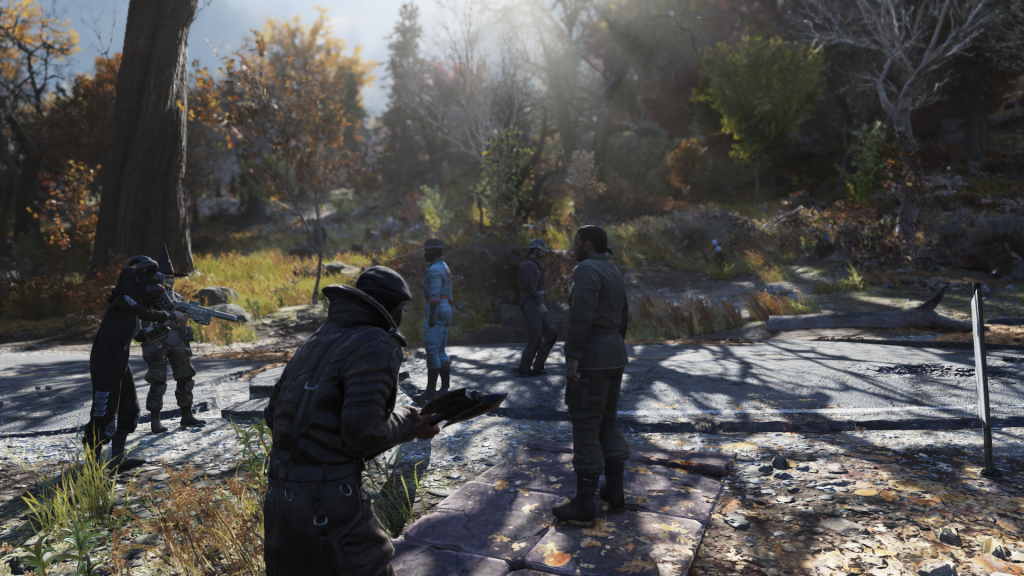
None of this is earth-shattering for longtime RPG players, but the new story content is well executed, a change from the normal gameplay loop, and integrated into the game fairly organically. Story-relevant NPCs are locked away in instanced rooms or buildings, keeping them safe from stray bullets or wandering Deathclaws. While this segmentation can feel a little artificial, it means you don’t have to wait in line to talk to Duchess or worry that Meg got mauled by a Yao Guai. It works, although it can be awkward with multiple players. I ran through some early game quests with a party of players and while they could hang out in the room with me while I talked to an NPC, they didn’t get credit for the quest, meaning they had to do everything twice. I don’t know if there’s something we missed or something bugged in the game, but for the time being we’re all doing the quests on our own, even if we’re on a server together. There’s also room for more factions to come in the future, and I imagine the positive reception from Wastelanders means we’ll be getting more story content down the road.
Dear Hearts and Gentle People
With the world’s NPC population returning, so has its human one. I’ve been seeing players from level 1 to level 300 running around, completing quests, and enjoying the game. I even joined a bunch of randos for an event where we had to gather bioluminescent goo to commune with Mothman. It was fun!
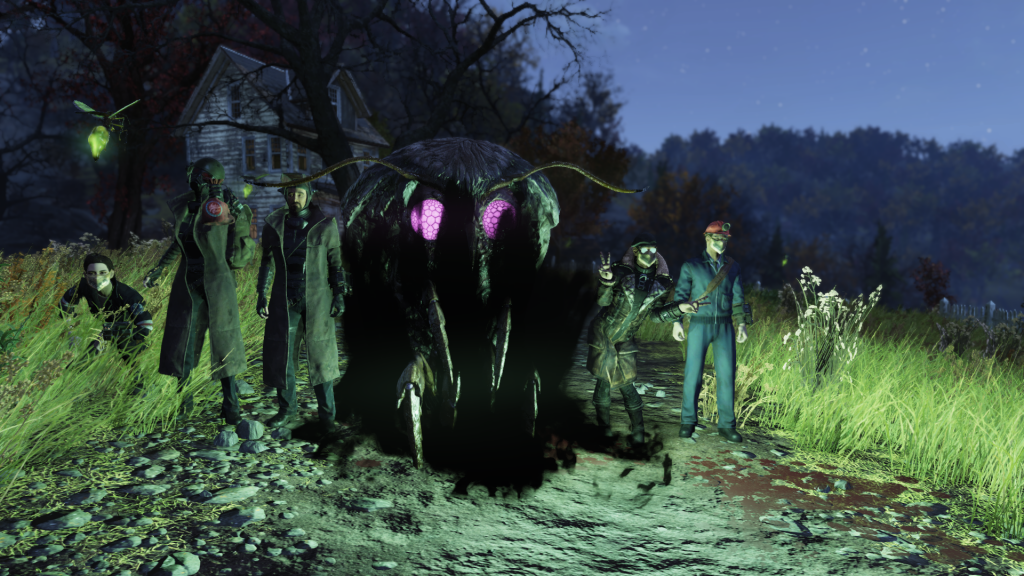
I’ve already touched on how generous and helpful the community tends to be, but even still you can run into would-be raiders and assassins prowling Appalachia. Combat is initiated by one player attacking the other for greatly reduced damage, then the second player returning the favor. Once both players have engaged, they do full damage and the gloves are off. Death means losing your junk, which is the currency of the scrap economy the game is built around. It’s not a massive loss, but if you’re carrying a bunch of precious strings and rolls of duct tape, it can be incentive enough to not die. Players who keep attacking other players build up a bounty that goes away once they’re brought to justice. I’ve had fun bounty hunting (and being hunted) a few times, though most of my PVP has been accidentally triggered by my own lack of trigger discipline with explosives. If you’d like, there’s a “Pacifist” setting in the options menu that turns off PVP damage completely. I leave it off as I like the unpredictability of hostile human players, but I’m not exactly tuning into the Hunter/Hunted radio station just to get into more PVP fights.
Playing with people is fortunately something you can do as much or as little of as you’d really like. Even on a full server, the map is big enough that you can go for long periods of time without running into any other players. Before Wastelanders, there wasn’t a whole lot of engaging single player content beyond digging up audiologs, but the new questlines breathe new life into solo play. I won’t go so far as to say they’re on the same level as New Vegas, but there’s enough there to keep a lone wanderer engaged. Most importantly, it finally feels like a Fallout game.

Still, traveling with a pack of other players is how I’d recommend most people play. I’ve never spent too much time with randos outside of the odd quest or event we happened to be in the same space for, but having a party means you can share perks and fast travel to each other’s C.A.M.P.s and player locations for free. Normally it costs a few caps (Fallout’s currency) to get around, but hopping from place to place for free or chaining fast travels together to get where you need to go incentivizes teamplay. I don’t really see the need for exclusive dedicated servers here, but if you really want to give Bethesda money every month for the premium Fallout 1st service, be my guest.
The last piece of multiplayer content to touch on here is Nuclear Winter, the trend-chasing battle royale mode. It’s accessed separately than the base game, so fortunately there’s not much cross contamination into the base game. It’s a condensed, faster-playing version of 76, with a ring of fire forcing players into tighter confines to kill each other. Players can build quickly like in Fortnite, collect whole sets of armor at once instead of stray parts to mix and match, and the goal is to be the last Vault dweller standing. Combat’s never been Fallout’s main draw (outside of the strictly-okay Fallout Tactics) but I feel like this has taken a lot of the more bloodthirsty players out of the base game’s adventure mode. XP, caps, and some unique craftable stuff carries over from Nuclear Winter to adventure mode, so it’s worth a look if you’re looking for something different.
Under an Orange Colored Sky
While we’re deep in the woods at this point, I think it’s time I took a moment to talk about Fallout 76 from an aesthetic point of view. It’s built on the bones of Fallout 4, going so far as to reuse heaps of that game’s assets, enemies, weapons, and UI elements. I don’t find issue with this as a general practice – games are hard to make, and if the same model for a Mole Rat is in two different games, why should I give a shit. Tons more is layered on top of that though, with new gear, craftable C.A.M.P. elements, monsters (including particularly inspired cryptids based on real-world local legends) and geography that keep things looking good and fresh.
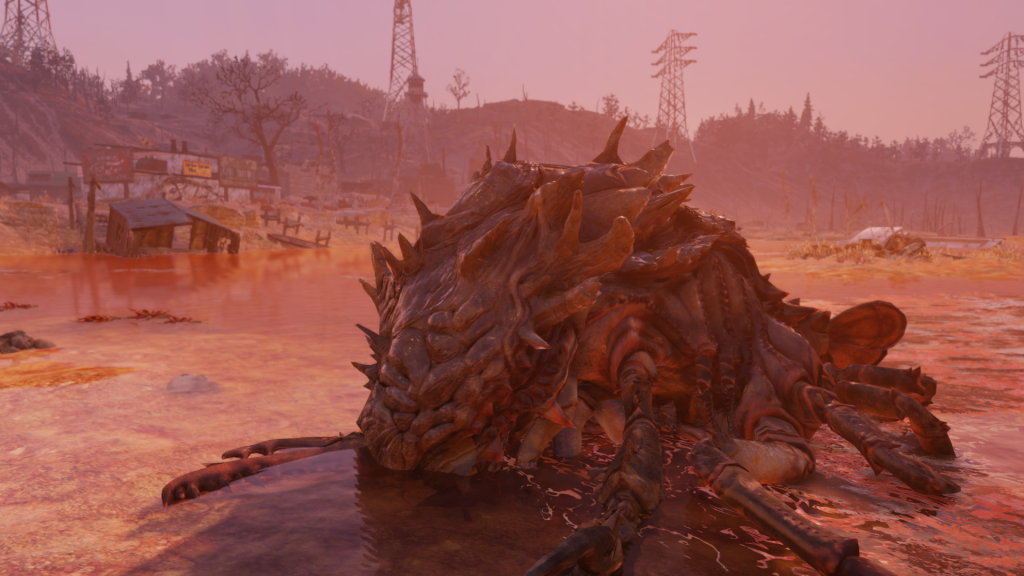
Each of the game’s six major regions are distinct as well. Vault 76, the game’s starting location, is based in The Forest, a borderline idyllic (if overgrown) take on the real forests of Appalachia. Strolling through stray sunbeams peeking through the canopy to the chirps and calls of local wildlife is downright pleasant. The Ash Heap is an apocalyptic extrapolation of industrial mining, with massive diggers and earth movers in the distance and toxic air that will kill you if you don’t have a respirator equipped. Toxic Valley and its abandoned theme park lie to the north, its ground poisoned by industry. The Savage Divide is dotted with snowy mountain peaks and abandoned ski resorts, and it (fittingly) divides the earlier areas of the world from the far more dangerous Mire and Cranberry Bog.
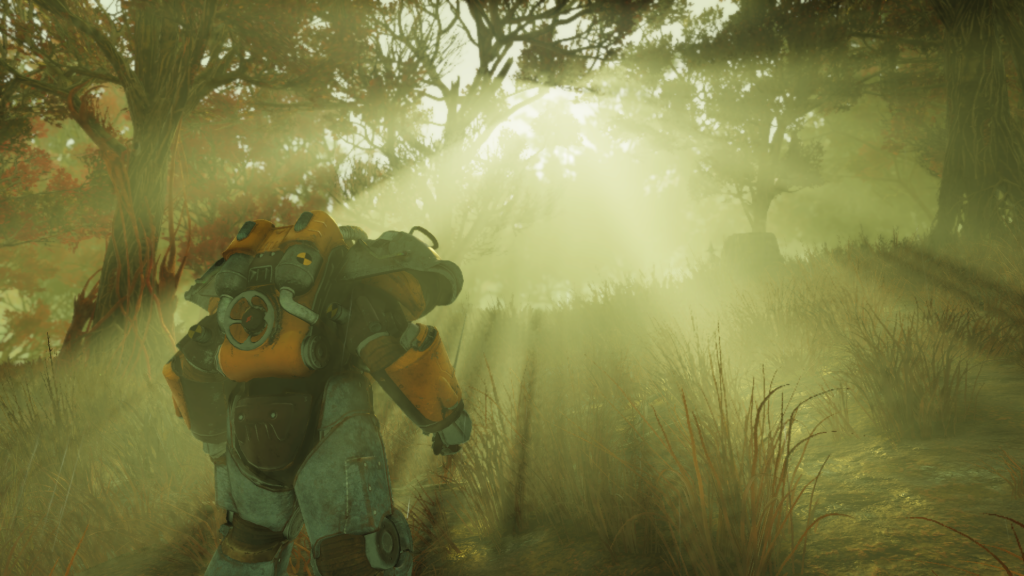
While up close the textures might be blurry or the models might look a bit dated, at a distance the world can look downright gorgeous. One of my favorite early memories was climbing a mountain in the largely empty southern side of the map, with nothing but the game’s sparse fiddles and strings to keep me company. As I hiked up the rocks and switchbacks in my power armor, I took in the sounds of the wind and the world around me, until finally I hit the peak. Trees, mountains, and the rusted husk of an old monorail stretched out before me as far as my PC could render, and I just sat up there and took it in. Feelings of limitless potential flooded into my mind, and it felt like the invisible walls behind me could open up into an endless wilderness at any moment. I hadn’t felt that way in an open world game since Breath of the Wild and the earlier Fallout 3 when I was in college, and I’ll treasure that experience here if nothing else.
On that lonely journey, my only accompaniment was the game’s soundtrack by Inon Zur. The soundtrack of each Fallout game has captured its respective atmosphere, with the harsh, hostile sounds of Fallout1 and 2, the “This is totally not Oblivion, guys” tunes of 3, to the hopeful pipes and keys of 4, the soundtrack has been a constant companion. Again, the soundtrack delivers, its instrumentation bringing to mind hazy hikes in the mountains as much as deep dives into the caverns below. Combat music doesn’t always trigger during encounters with enemies which is a bit jarring, but overall I’d rate the score in this game as some of the best in the series. Wastelanders adds even more music to the mix, and it blends in with the rest seamlessly.
Of course, in the post-Fallout 3 world, Bethesda leans hard on licensed music from the 40s, 50s, and 60s to set the stage. Ignoring the fact that seemingly nobody recorded anything after The Beach Boys’ Pet Sounds in 1966 (which, as far as last albums ever recorded by civilization go, would have been a damn good one), the licensed music does a good job of capturing that midcentury Americana feel. It plays sort of like a greatest hits collection of radio tracks from previous Fallouts, with a mix of old favorites (It’s All Over But the Crying, Butcher Pete), thematic, seemingly obvious additions (Praise the Lord and Pass the Ammunition, Sixteen Tons), too on-the-nose, even for me tracks (Uranium), and un-favorites I never want to hear again (Civilization – Bongo, Bongo, Bongo). Much like in Fallout 4, I find the game’s score to be so good I don’t often need to turn on the radio on my Pip-Boy, but it’s cool to hear those tracks coming out of radios and jukeboxes around the world. There’s even a DJ now, who does the typical modern Fallout DJ thing of leaving breadcrumbs for quests, commenting on in-world happenings, and so on.
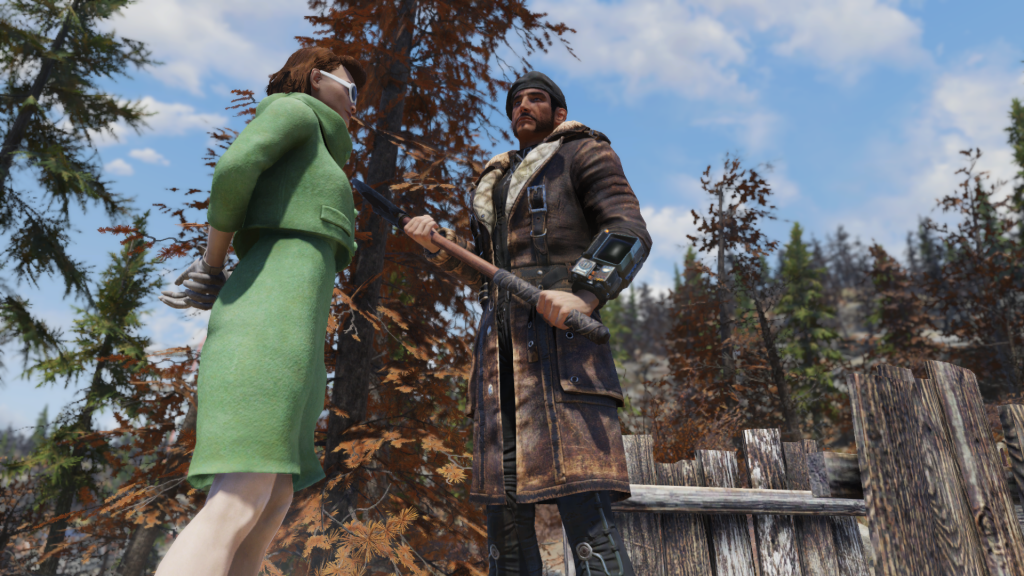
Country Roads, Take Me Home
Fallout 76 launched as a game I could only recommend to series diehards, and even then with a number of caveats. My specific situation where I was in the same room as the person I was playing with definitely made it more enjoyable, but it was clear the game had a number of serious problems. There were no problems quite as bad as what the loudest YouTubers and caps locked reviewbombers were yelling about, but problems nonetheless. With Wastelanders, Bethesda has delivered a healthy dose of Buffout to what was a flagging game, and bulked it out into something I can say is honestly worth the time. The new content is seeded throughout, even woven into quests I remember doing at launch back in 2018, so I don’t feel like my previous time was wasted or disrespected. The characters and quests stand on their own, but still hit just enough nostalgia and series lore notes to keep me happy. I would hardly say it’s the best game in the series (New Vegas is the Big Iron on my heart) but it’s a worthwhile endeavour for any Fallout fan, especially if they can bring some friends along.


